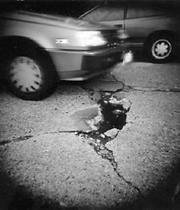“I’D SAY 95 PERCENT of people are really happy to see you,” says T.C. Carey. He’s driving the pothole rangers’ self-contained street-patching truck, carrying a load of B-modified mix asphalt to perform emergency surgery on a heavily traveled stretch of Wallingford’s North 45th Street.
Carey and his Seattle Transportation (Seatrans) crewmates usually get cast as heroes: protecting motorists, pedestrians, and cyclists from gaping holes in the city’s aging streets. But the state of the streets has put city officials in the bad-guy role—Seattle residents rated the condition of roads as their number one point of dissatisfaction with city government. The business lobby is pressing for an immediate cash transfusion to the city’s road budget.
“We’re not talking about new streets, we’re just talking about maintaining what we’ve got,” says Chuck Holland, chair of the Seattle Transportation Committee. This coalition—comprised of the heavy hitters (the Downtown Seattle Association and the Greater Seattle Chamber of Commerce) and the mom-and-pops (the Neighborhood Business Council)—is tired of seeing transportation projects end up at the end of the city funding queue.
Currently, Seatrans gets about $35.1 million from the city’s $536.7 million general fund (about 6.3 percent of the total). The Seattle Transportation Committee wants Mayor Paul Schell and the City Council to give Seatrans another $21 million of general fund money per year.
City Council member Richard McIver, chair of the council’s transportation committee, says the demands are unrealistic. “Are we going to take [the money] away from parks? Are we going to take it away from health? Are we going to take it away from public safety?” asks McIver. “The general fund is only so big.”
McIver is proposing an increase of around $5 million in next year’s Seatrans budget. The council could also choose to earmark the funds from the annual six percent property tax increase (about $9.2 million) to street projects, an approach backed by transportation committee member Heidi Wills. In the future, McIver hopes to slap a tax on commuter parking that would bring in an extra $20 million annually, but he needs approval from the state Legislature in order to do it.
Holland says businesses aren’t willing to wait for the Legislature to get around to addressing Seattle’s road problems. “Obviously Olympia is not doing anything—they can’t even pass a budget this year,” he notes. “We’ve got to look locally.”
The city proposed a $90 million bond issue to catch up on street work in 1997, but it didn’t win at the polls. City officials would like to try again with the voters, but indications are that parks funding will get the first crack at this fall’s ballot.
Once again, Holland argues that the issue won’t wait. “Aside from trying to pass bond issues and looking elsewhere, the City Council has got to address the issue,” he says. Suzie Burke, a longtime Fremont business leader, agrees. “This is pretty basic stuff. I think it’s right up there with police and fire.”
McIver knows this sentiment well. Although many of the city’s smaller streets were constructed at the expense of developers or adjoining property owners, all are now the property of city government. And even the city’s concrete streets—the sturdiest of the bunch—should be replaced every 60 years, a schedule that can’t be met at current funding levels.
When the voters statewide cut taxes by passing Initiative 695 last November, Seattle had to trim its already stretched transportation budget by $4.5 million. The entire amount came out of funds allocated for construction of new concrete streets.
Even though repair money was protected from the I-695 ax, the costs of constant road mending can be unpredictable. Take the pothole rangers’ most recent project. Assigned to remove an asphalt ridge created by overweight Metro buses pulling into a stop, the crew found the compressed asphalt to be unusually hard. As the crew’s jackhammer repeatedly stuck in the pavement, the job a supervisor had confidently predicted would take an hour instead lasted all morning.
Business representatives say the costs of fixing crumbling streets will continue to mount unless the city assembles a large enough road budget to allow Seatrans to catch up on a $100-million-plus backlog of projects. They also say the money should be there. Not only has the general fund grown by almost 20 percent in the last four years (from $452.2 million in 1996 to last year’s $537.6 million) but some 42 percent of that total comes from two business-generated sources—sales tax and the city’s business and occupation tax.
Curiously, both Burke and McIver cited the Fremont Bridge when discussing the risks of deferred transportation maintenance. Burke is worried about the integrity of the bridge’s 1916 approaches; McIver about the continued functioning of its original gears. Perhaps this is a sign that the council and the business community can start building some bridges after all.






